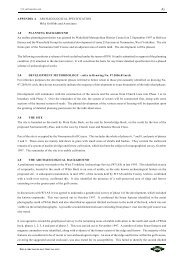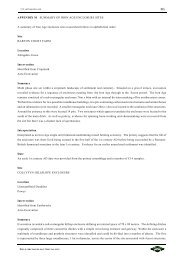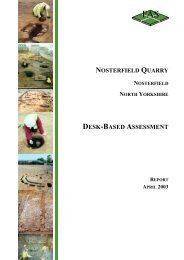ARCHAEOLOGICAL EVALUATION - Mike Griffiths and Associates
ARCHAEOLOGICAL EVALUATION - Mike Griffiths and Associates
ARCHAEOLOGICAL EVALUATION - Mike Griffiths and Associates
Create successful ePaper yourself
Turn your PDF publications into a flip-book with our unique Google optimized e-Paper software.
FAS_lbf01.wpd 44<br />
6.0 GEOPHYSICAL SURVEY<br />
A targeted magnetometer pilot study was undertaken in November 2003 in order to assess the effectiveness of<br />
magnetometry on the site. Although the results were not wholly conclusive, a magnetometer area survey of 12<br />
hectares was carried out in Zones A, B, C, <strong>and</strong> D, during December 2003. Given the relatively disappointing<br />
results of the magnetometer area survey, a targeted soil resistance pilot study was undertaken in January 2004.<br />
A soil resistance area survey covering 2 hectares was then employed to investigate Zone D during February 2004<br />
(Figure 23).<br />
6.1 SURVEY PROCEDURE<br />
The external edges of the survey areas were set out using a total station theodolite, with intermediate points<br />
being positioned using tapes. This procedure ensured an internal grid point accuracy of ±0.05m for the survey.<br />
6.1.1 Magnetometer survey<br />
Magnetometry measures subtle magnetic variation against a consistent magnetic background. Metalwork creates<br />
significant magnetic variation, while archaeological features <strong>and</strong> deposits which contain debris from burning<br />
or organic decay will create more subtle variations, both of which can be mapped.<br />
This survey was carried out using a fluxgate gradiometer with digital storage <strong>and</strong> data transfer facilities (FM36<br />
with ST1 sample trigger - manufactured by Geoscan Research). Each survey grid was undertaken using the<br />
parallel traverse method (unidirectionally) to ensure the capture of good quality raw data. Instrument readings<br />
were logged at 0.25m intervals along 1.0m traverses. On the completion of four survey grids the data was<br />
transferred from the FM36 to a portable computer where it was checked for survey defects.<br />
The raw data was processed using Geoplot version 2.02. This involved the adjustment of any differences in the<br />
average background reading between individual survey grids as well as inconsistencies caused by instrument<br />
drift, which were removed to facilitate clear presentation of the data sets. The processed data was transferred<br />
to Surfer version 6.2 in which it was prepared for presentation <strong>and</strong> the resulting greyscale images were imported<br />
into AutoCAD <strong>and</strong> output on a high definition laser printer. Raw data <strong>and</strong> trace plots are provided as Appendix<br />
C.<br />
6.1.2 Soil resistance survey<br />
This technique involves passing an electrical current through an area of ground <strong>and</strong> measuring the ground’s<br />
resistance to the current. Although soil particles <strong>and</strong> stone are insulators <strong>and</strong> do not conduct electricity, the<br />
presence of water which is a good conductor allows these materials to conduct an electrical current. In effect,<br />
a soil resistance survey maps moisture content. Archaeological deposits vary in character <strong>and</strong> composition <strong>and</strong><br />
have different moisture retention qualities which can often be mapped by a soil resistance meter.<br />
This survey was carried out using a soil resistance meter with digital storage <strong>and</strong> data transfer facilities (RM15<br />
Advanced - manufactured by Geoscan Research). The RM15 was used with a MPX15 multiplexer connected<br />
FIELD ARCHAEOLOGY SPECIALISTS







